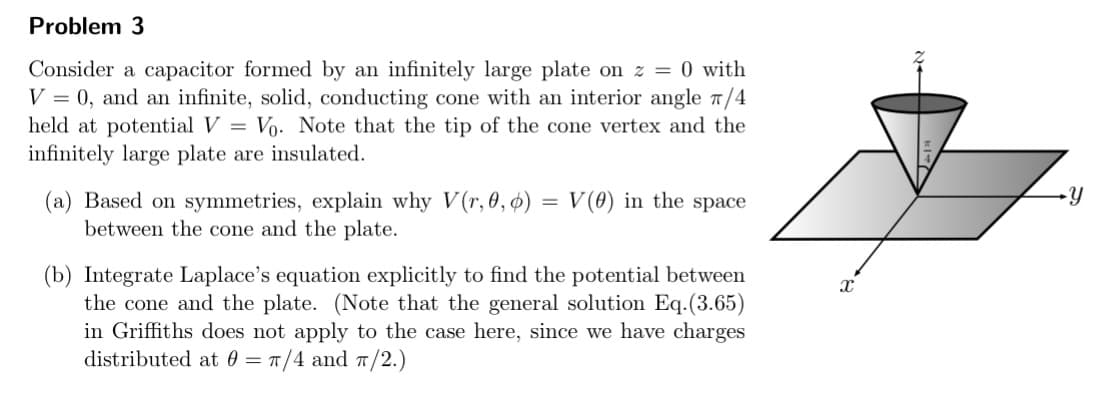Problem 3 Consider a capacitor formed by an infinitely large plate on z = 0 with V = 0, and an infinite, solid, conducting cone with an interior angle a/4 held at potential V = Vo. Note that the tip of the cone vertex and the infinitely large plate are insulated. (a) Based on symmetries, explain why V(r, 0, ¢) = V (0) in the space between the cone and the plate. (b) Integrate Laplace's equation explicitly to find the potential between the cone and the plate. (Note that the general solution Eq.(3.65) in Griffiths does not apply to the case here, since we have charges distributed at 0 = T/4 and T/2.)
Problem 3 Consider a capacitor formed by an infinitely large plate on z = 0 with V = 0, and an infinite, solid, conducting cone with an interior angle a/4 held at potential V = Vo. Note that the tip of the cone vertex and the infinitely large plate are insulated. (a) Based on symmetries, explain why V(r, 0, ¢) = V (0) in the space between the cone and the plate. (b) Integrate Laplace's equation explicitly to find the potential between the cone and the plate. (Note that the general solution Eq.(3.65) in Griffiths does not apply to the case here, since we have charges distributed at 0 = T/4 and T/2.)
Principles of Heat Transfer (Activate Learning with these NEW titles from Engineering!)
8th Edition
ISBN:9781305387102
Author:Kreith, Frank; Manglik, Raj M.
Publisher:Kreith, Frank; Manglik, Raj M.
Chapter3: Transient Heat Conduction
Section: Chapter Questions
Problem 3.1P: Consider a flat plate or a plane wall with a thickness L and a long cylinder of radius r0. Both of...
Related questions
Question

Transcribed Image Text:Problem 3
Consider a capacitor formed by an infinitely large plate on z = 0 with
V = 0, and an infinite, solid, conducting cone with an interior angle 7/4
held at potential V = Vo. Note that the tip of the cone vertex and the
infinitely large plate are insulated.
(a) Based on symmetries, explain why V(r, 0, ø) = V(0) in the space
between the cone and the plate.
%3D
(b) Integrate Laplace's equation explicitly to find the potential between
the cone and the plate. (Note that the general solution Eq.(3.65)
in Griffiths does not apply to the case here, since we have charges
distributed at 0 = 1/4 and T/2.)
Expert Solution
This question has been solved!
Explore an expertly crafted, step-by-step solution for a thorough understanding of key concepts.
This is a popular solution!
Trending now
This is a popular solution!
Step by step
Solved in 2 steps with 2 images

Recommended textbooks for you

Principles of Heat Transfer (Activate Learning wi…
Mechanical Engineering
ISBN:
9781305387102
Author:
Kreith, Frank; Manglik, Raj M.
Publisher:
Cengage Learning

Principles of Heat Transfer (Activate Learning wi…
Mechanical Engineering
ISBN:
9781305387102
Author:
Kreith, Frank; Manglik, Raj M.
Publisher:
Cengage Learning